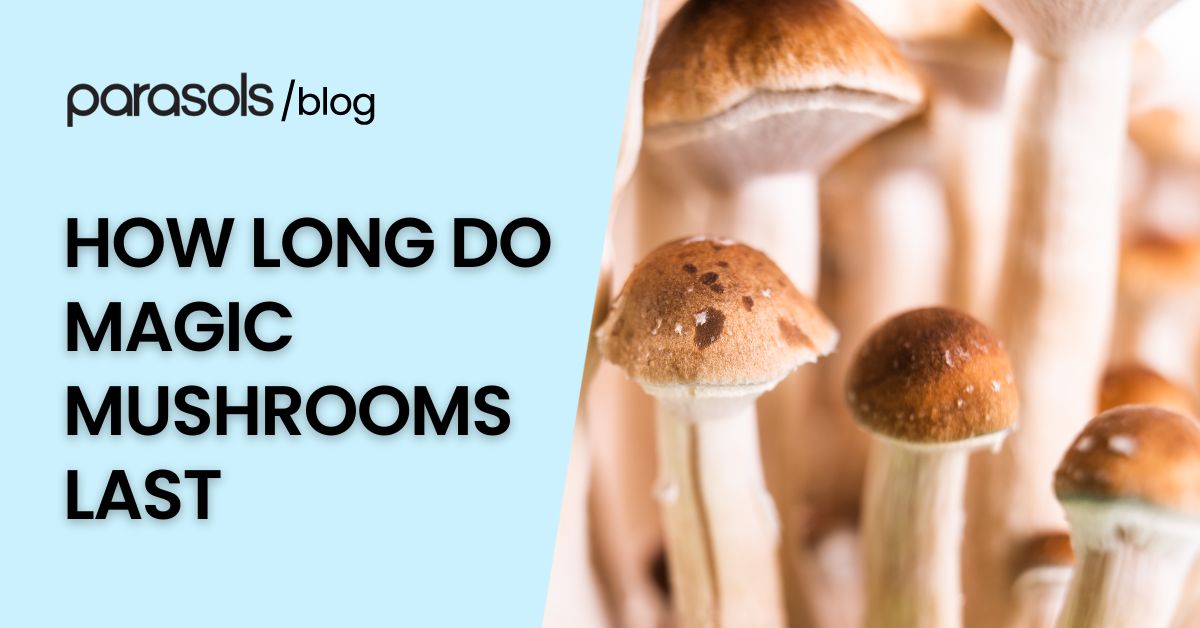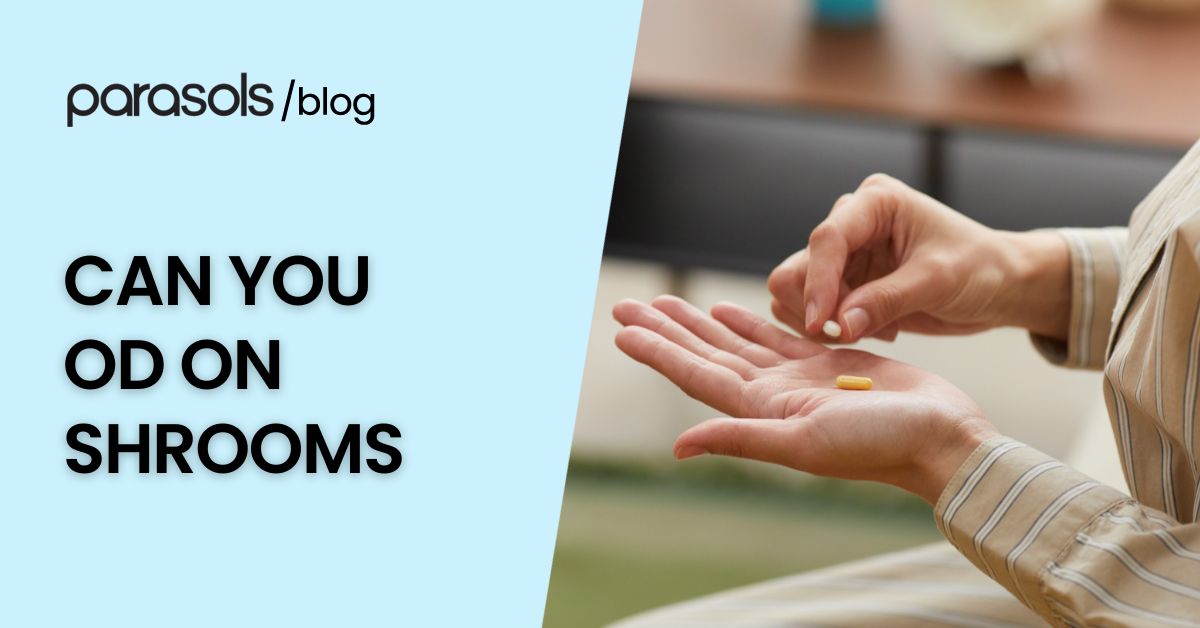Sometimes when people take psilocybin mushrooms, one of the first questions that comes up is how long for shrooms to kick in. The truth is, the onset of psychedelic effects isn’t the same for everyone—it can vary depending on your body, the way you consume magic mushrooms, and even whether you’ve eaten recently.
Knowing what influences the timing can help set expectations and create a more supportive environment for the experience.
Key Takeaways
- Shrooms usually take 20–60 minutes to kick in, depending on factors like dosage, stomach contents, body metabolism, species, and mindset
- Methods like tea or lemon tek may speed up onset compared to chewing dried mushrooms
- Empty stomachs often bring quicker effects, while food delays absorption
- Peak effects generally occur 2–3 hours after ingestion and taper off over 4–6 hours
- Preparing the right environment, starting with a mindful dose, and having a trip-sitter can make the experience safer and more meaningful
What are Shrooms?
Shrooms, often called magic mushrooms, are a group of fungi that contain psilocybin, a naturally occurring psychedelic compound. Once ingested, the body converts psilocybin into psilocin, which interacts with serotonin receptors in the brain to produce hallucinogenic effects.
How Long for Shrooms to Kick In?

Shrooms usually take about 20 to 60 minutes to kick in, though the exact onset time varies depending on several factors such as body weight, metabolism, the mushroom species, dosage, and whether they’re consumed on an empty or full stomach. Some people may feel initial effects sooner, while for others it can take closer to an hour before noticeable psychedelic effects begin.
Factors Affecting Onset Time of Magic Mushrooms
Several factors influence how quickly the effects of magic mushrooms begin. Understanding these can help set realistic expectations and reduce uncertainty during shroom consumption.
Dosage and Mushroom Species
Higher doses of psilocybin mushrooms or more potent species like psilocybe cubensis typically lead to a faster and more intense onset. Lower doses or weaker mushroom species may take longer for noticeable effects to appear.
Method of Consumption
The way shrooms are taken can change onset time. Eating dried mushrooms raw or in food may slow digestion, while making mushroom tea or mixing with lemon juice can speed up absorption, leading to a quicker and sometimes more intense onset.
Empty vs. Full Stomach
Taking magic mushrooms on an empty stomach often results in a faster onset because the body processes psilocybin more quickly. On a full stomach, digestion slows, which can delay the initial effects.
Body Weight and Metabolism
Individual body weight, metabolism, and how efficiently the body converts psilocybin into psilocin all affect when the shroom trip begins. Faster metabolisms generally experience effects sooner, while slower metabolisms may take longer.
Set and Setting
Although not physical factors, a person’s mindset and environment can influence how soon the psychedelic effects are noticed. A calm, supportive environment may make it easier to recognize the initial effects, while stress or distraction could delay awareness of changes in perception.
How to Take Shrooms for Best Effects
When preparing to take shrooms, small choices can shape the entire experience. Being intentional about dosage, environment, and mindset can help bring out the most meaningful effects while lowering the chances of discomfort. Here are some of the best tips to keep in mind:
- Start with a mindful dose – If it’s your first time consuming psilocybin mushrooms, begin with a low amount (often 1–2 grams of dried mushrooms). This allows your body to adjust to the hallucinogenic effects without overwhelming you. Experienced users sometimes pursue higher doses, but starting small helps reduce risks.
- Choose the right environment – Where you take shrooms matters. A calm, supportive environment, free from stress and interruptions, encourages a smoother journey. Many people prefer a cozy room or nature setting where they feel safe and relaxed.
- Consider your stomach – Taking shrooms on an empty stomach often makes the effects kick in faster and feel stronger. However, if you’re prone to nausea, having a light snack beforehand can ease digestion without delaying the onset too much.
- Try different methods – Shroom consumption doesn’t have to mean chewing dried mushrooms raw. Brewing mushroom tea, mixing with lemon juice (“lemon tek”), or blending into food can reduce stomach discomfort and sometimes intensify or speed up the onset of psychedelic effects.
- Have a trusted companion – A sober or experienced trip-sitter can make a big difference, especially if panic attacks or confusion arise. Having someone present to reassure and ground you helps create a safer and more comfortable experience.
- Focus on mental state – Psychedelic mushrooms tend to amplify your current mindset. Entering with clear intentions, a positive outlook, and an open mind increases the chance of meaningful insights and lowers the risk of anxiety during the trip.
- Stay hydrated and comfortable – Keep water nearby, dress in comfortable clothes, and prepare a cozy space. A blanket, calming music, and a safe environment can help when the psychedelic effects become intense or emotionally overwhelming.
Final Thoughts

In the end, how long for shrooms to kick in depends on several factors—your body, the way you consume them, and the setting you’re in. By starting with a mindful dose, preparing your environment, and understanding how your body processes psilocybin mushrooms, you can set yourself up for a safer and more meaningful experience.
If you’re curious about learning this journey yourself, consider taking the step and try shrooms for the experience. Parasols offer high quality mushroom gummies like our wildberry non detect shroom gummies.
Frequently Asked Questions
How long do shrooms stay in your system?
Psilocybin mushrooms generally leave the body within 24 hours, but traces of psilocin—the active compound—may remain detectable for a few days. Standard urine tests usually don’t screen for psilocybin, though specialized drug tests can detect it. Saliva tests are less common but may also reveal use within a short time frame.
When do shrooms peak during a trip?
The peak effects of magic mushrooms usually occur about 2 to 3 hours after ingestion. This is when visual and auditory hallucinations, altered perception, and heightened sensory awareness are most intense. After the peak, effects gradually decline over several hours.
Can you develop a dependence on shrooms?
While psilocybin mushrooms are not considered physically addictive, repeated use can lead to psychological dependence for some individuals. People may find themselves craving the altered states or insights from shroom trips, which is why moderation and mindful use are important.
What are the risks of mixing shrooms with other substances?
Combining shrooms with alcohol, cannabis, or other hallucinogens can increase the risk of negative reactions such as nausea, panic attacks, or overwhelming hallucinations. Mixing with stimulants or depressants may also put stress on the body and lead to unpredictable experiences.
How do different mushroom species affect the experience?
Not all psychedelic mushrooms contain the same levels of psilocybin. For example, psilocybe cubensis is among the most common and moderately potent species, while others like psilocybe azurescens contain much higher concentrations. This means the onset, intensity, and duration can vary significantly depending on the species consumed.
Is psilocybin therapy the same as recreational shroom use?
Psilocybin therapy involves carefully guided sessions in controlled environments, often as part of clinical research on mental health issues such as depression or anxiety. Recreational use, by contrast, lacks this medical structure and carries more risks if taken without preparation or support.



Leave a comment
All comments are moderated before being published.
This site is protected by hCaptcha and the hCaptcha Privacy Policy and Terms of Service apply.